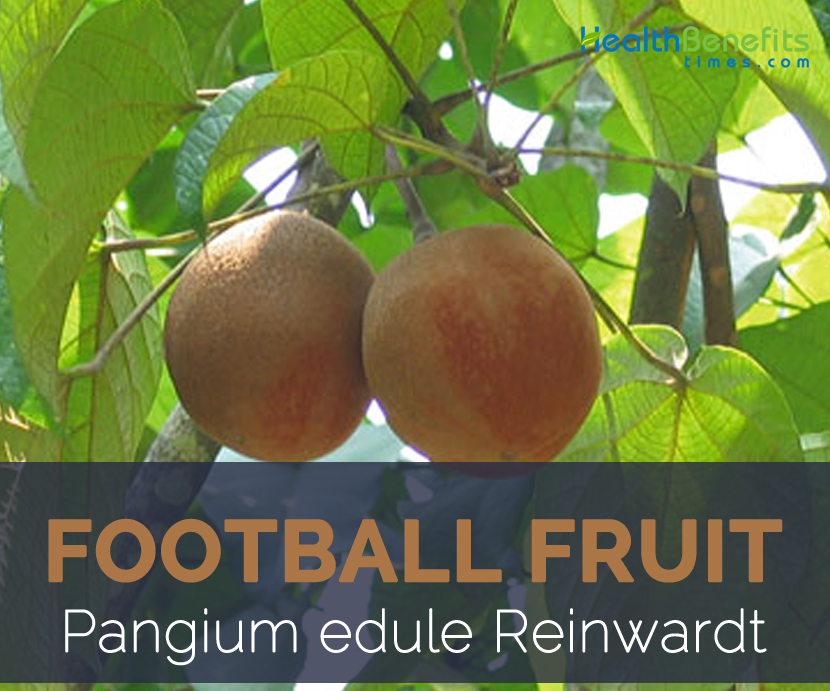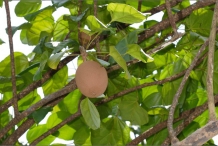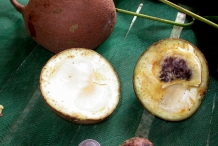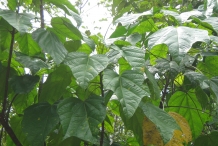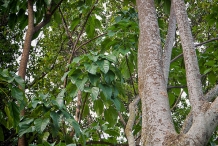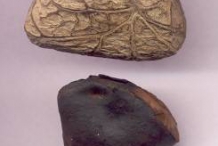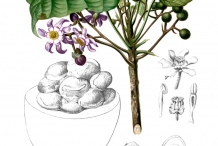| Football Fruit Quick Facts |
| Name: |
Football Fruit |
| Scientific Name: |
Pangium edule Reinwardt |
| Origin |
Malesia, Melanesia and Micronesia |
| Colors |
Brown |
| Shapes |
Large, sub globose to ovoid-sub pyriform (football shaped), indehiscent, rough, brown, generally 15–30 cm long, and about half as thick |
| Flesh colors |
Creamy-white or yellowish |
| Taste |
Similar to durian fruit |
| Calories |
227 Kcal./cup |
| Major nutrients |
Total Fat (57.71%)
Iron (26.25%)
Total dietary Fiber (25.26%)
Magnesium (23.10%)
Vitamin C (21.11%)
|
| More facts about Football Fruit |
Pangium edule commonly known as football Fruit, Sis Nut is a tall tree native to Malesia, Melanesia and Micronesia that produces a fruit with size and shape of a football and is member of Achariaceae family. Hence its names, football fruit, also known as pangi, kepayang and pakem. Its taste and odor have been compared to durian fruit. The seeds bark and leaves are poisonous. The seeds are used to kill rats and wild chickens, and the bark and leaves are used to stun fish so they can be scooped up easily.
Plant
Football fruit is a medium to large, much branched, evergreen perennial tree growing up to 18–40 m tall. It grows well in tropical rain forests and secondary forests. Yet the tree is shade loving. It prefers slightly acidic soil. It is also found growing along riverbanks and flooded areas and on stony and clayey soils. Leaves are spiral, clustered at twigs on long petioles at the shoot apex. Leaves are entire, broadly ovate, cordate to truncate base, 15–25 cm long, 3-lobed on young trees, acuminate, glossy green, nerves palmate. Flowers are mostly unisexual; male flowers occur in racemes, to 5 cm wide; with 2–3 calyx-lobes; 5 or 6 petals with a basal scale and many stamens. Female flowers are solitary, similar to male flowers, but have no stamens but with 5–6 staminodes alternating with the petals, ovary long-ovoid, thick-walled, 1-celled with 2–4 placentae and many ovules and sessile stigma.
Fruit
Football fruit is a large, sub globose to ovoid-sub pyriform (football shaped) fruit, indehiscent, rough, brown, generally 15–30 cm long, and about half as thick. Fruit is normally brown colored with thick skin which encloses creamy-white or yellowish pulp. Many seeds are found that are compressed ovate, greyish, 5 cm long, the hard seed coat with prominent raised nerves and embedded in creamy-white or yellowish pulp. Its taste and odor have been compared to durian fruit. The leaves, barks and seeds are poisonous. The bark and leaves are used to stun fish so they can be scooped up easily and seeds are used to kill wild chickens and rats.
History
Football fruit is considered to have originated throughout Micronesia, Malesia and Melanesia. They are grown wild and cultivated in Malaysia, Indonesia, Papua New Guinea and Vanuatu. Because of its wonderful nutritional value and health promoting benefits the fruit is nowadays cultivated throughout the world.
Nutritional value
Apart from their taste just like durian, Football fruit is a good source of nutrients, vitamins and minerals. Consuming 100 gram of Football fruit offers 20.2 g of Total Fat, 2.1 mg of Iron, 9.6 g of Total dietary Fiber, 97 mg of Magnesium, 19 mg of Vitamin C, 7.3 g of Protein, 401 mg of Potassium, 30 mg of Phosphorus, 42 mg of Calcium and 4.1 g of Carbohydrate.
How to Eat
- Within Papua New Guinea, the seed kernel is consumed in most provinces after extensive processing to remove a toxic substance, a cyanogenic glycoside.
- Seed kernels are consumed after processing the seed by washing, fermentation and roasting or cooking in Papua New Guinea and Fiji.
- In Papau, the seed kernel is only eaten after being washed in water, and then roasted and fermented seeds cooked with sago in bamboo tubes over fire.
- After soaking the kernels are cut up and used as vegetable.
- Fried with meat or fish makes a savory dish; alternatively the seeds are left in wood ash for several months to ferment.
- Keluak seed kernels are used in the Nyonya speciality cuisine such as Ayam buah keluak or babi buah keluak in Malaysia and Singapore.
- In Sabah, it is used in Bosou a signature dish for Kadazan Dusun which includes ingredients like raw freshwater fish, pangi, salt, steamed rice and some other optional ingredients such as jackfruits, young pineapple fruits, tahu (bean curd), etc.
- Seed kernels are used as an important basic ingredient for bumbu rawon – a mixture of spices: kemiri (candlenut), asam jawa (tamarind), kluwak (sisnut), bawang putih (garlic), kunyit (turmeric), lenguas (galangal), jahe (ginger) and lada (chilli) in Indonesia.
- Soto Rawon is a much savored Indonesian soup with beef.
- This dark beef soup is served with mung bean sprouts and sambal.
- Young leaves also are edible after cooking and are cut into small pieces and used in the preparation of preserved meat ‘kasam’ in Sarawak.
- Edible oil obtained from the seeds is used for cooking in places where coconut was unavailable.
Traditional Uses and benefits of Football Fruit
- Seeds are stated to possess anthelmintic and narcotic properties in traditional medicine.
- All parts of the tree are considered to be anthelmintic in Philippines.
- In Malaysia, Fresh crushed seeds have been used for boils and the leaves being anthelmintic were mixed with lime juice and salt and use for itch due to parasite, ulceration, wounds, and scurf in Malaysia.
- Penan consumes a decoction of the bark for constipation in Sarawak.
- A solution made from the seeds is used as shampoo and to remove head lice while oil extracted from the seeds is used as hair cream to produce healthy and shiny hair.
- The Iban apply sap from the inner bark as antiseptic to treat wounds.
- Young leaves are rubbed on the skin to treat infections.
- Fruit is sliced and the fruit juice is applied for sores and cuts in Papua New Guinea.
- All parts are credited with possessing narcotic attributes and an overdose will result in sleepiness, headache and intoxication leading to delirium and death in extreme cases.
Other Facts
- Seeds possess antiseptic property and are pounded and used for preservation of fish and shrimps in Java.
- Seeds are used to kill rats and wild chickens, and the pounded bark and leaves are used to stupefy fish so they can be scooped up easily.
- Kepayang oil has been used for making soap and to provide a red dye.
- Wood has been used for matchsticks.
Precautions
- Seeds and leaves are poisonous when consumed raw without thorough processing and preparation.
References:
https://sv.wikipedia.org/wiki/Pangium_edule
http://www.hear.org/pier/species/pangium_edule.htm
https://florafaunaweb.nparks.gov.sg/Special-Pages/plant-detail.aspx?id=3050
https://www.itis.gov/servlet/SingleRpt/SingleRpt?search_topic=TSN&search_value=837784#null
Comments
comments


